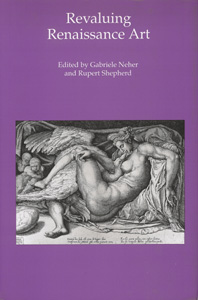
Details
Edited by Gabriele Neher and Rupert Shepherd
Ashgate, 2000
255 pages, 42 black-and-white illustrations
hardback
ISBN 0 7546 0169 2
2nd edition (unaltered):
Routledge, 2017
hardback: ISBN 978-1-138-73424-1
eBook: ISBN 978-1-315-18731-0
paperback: ISBN 978-1-138-73419-7 (published December 2018)
Buy a copy
New hardback copies of the first edition are available from the authors for £15.00 + postage at cost. Payment via PayPal. That’s an 85% saving over the cost of a hardback from the publisher, and 63% over the cost of the eBook.
To buy a copy, please get in touch via the Contacts page in this site, and I’ll calculate postage and send you a PayPal invoice email.
Reviews
… an engaging guide to new perspectives on the definition and the appreciation of Renaissance art in its time and for ours. (Patricia Rubin, Times Literary Supplement, 30 March 2001 (subscription required))
… we cannot make judgements until we have thought more about what exactly we mean by worth or value. This book makes a valuable contribution to the maturation of this process. (Carol M. Richardson, The Art Book)
… a welcome addition to the growing body of literature on consumption and consumerism in the Renaissance … scholars will find Revaluing Renaissance Art to be an engaging and worthy text, particularly for its varied viewpoints and the multiplicity of ‘values’ it documents and investigates. (Rosi Prieto Gilday, CAA.reviews)
… Revaluing Renaissance Art offers some interesting insights on the evaluation of knowledge and things in Renaissance Italy. (Mary Bergstein, Renaissance Quarterly)
The essays meet a felt need and are often eye-opening … it must be said that the book is good value for money. (Leonard R.N. Ashley, Bibliothèque d’humanisme et renaissance: travaux et documents, Tome LXIII, No 3, 2001, pp. 597-618; p. 603)
These essays are equally valuable to historians, art historians, and feminists, even scholars who study the history of science, and add new dimensions to modern understanding of the complex world of the Renaissance. (Sara Nair James, The Sixteenth Century Journal)
Summary
Michelangelo gave his painting of Leda and the Swan to an apprentice, rather than hand it over to the emissary of the Duke of Ferrara, who had commissioned it. He was apparently disgusted by the failure of the emissary – who seems to have been more used to buying pigs than discussing art – to accord the picture and the artist the value they deserved.
Any discussion of works of art and material culture implicitly assigns them a set of values. Whether these values be monetary, cultural or religious, they tend to constrict the ways in which such works can be discussed. The variety of potential forms of valuation becomes particularly apparent during the Italian Renaissance, when relations between the visual arts and humanistic studies were undergoing rapid changes against an equally fluid social, economic and political background.
In this volume, thirteen scholars explicitly examine some of the complex ways in which a variety of values might be associated with Italian Renaissance material culture. Papers range from a consideration of the basic values of the materials employed by artists, to the manifestation of cultural values in attitudes to dress and domestic devotion. By illuminating some of the ways in which values were constructed, they provide a broader context within which to evaluate Renaissance material culture.
Contents
- Introduction, Gabriele Neher and Rupert Shepherd
- The price of quality: factors influencing the cost of pigments during the Renaissance, Jo Kirby
- ‘Artefici’ and ‘huomini intendenti’: questions of artistic value in sixteenth-century Italy, Ben Thomas
- ‘Dante Alighieri poeta fiorentino’: cultural values in the 1481 Divine Comedy, Sally Korman
- Mantegna’s Parnassus: reading, collecting and the studiolo, Stephen J. Cambell
- Alfonso I d’Este, Michelangelo and the man who bought pigs, Charles M. Rosenberg
- New, old and second-hand culture: the case of the Renaissance sleeve, Evelyn Welch
- Evaluating textiles in Renaissance Venice, Mary Rogers
Revaluing dress in history paintings for quattrocento Florence, Caroline Campbell - The Madonna and Child, a host of saints, and domestic devotion in Renaissance Florence, Jaqueline Marie Mussacchio
- Images of Saint Catherine: a re-evaluation of Cosimo Rosselli and the influence of his art on the woodcut and metal engraving images of the Dominican third order, Anabel Thomas
- Voting with their feet: art, pilgrimage and ratings in the Renaissance, Robert Maniura
- Madness, reason, vision and the cosmos: evaluating the drawings of Opicinus de Canistris (1296–c.1351), Catherine Harding
- Bibliography
- Index
